Kyoto University and Panasonic Corporation have revealed today a new technology they’ve been working on together, which enables remote detection of vital signs.
Heart rate, heartbeat intervals and other such vital signs will soon be measured without placing sensors on the body, fact that can be quite stressful, especially for young people. Arrhythmia resulting from such stress could be misinterpreted as a genuine heart problem, and patients could end up taking a treatment for a disorder they don’t actually have. Researchers at Panasonic and Kyoto University have created a technology based on a high sensitive spread-spectrum radar and feature-based heartbeat interval estimation algorithm that rivals electrocardiographs in accuracy.

“Taking measurements with sensors on the body can be stressful and troublesome, because you have to stop what you’re doing,” explained Hiroyuki Sakai, a researcher at Panasonic. “What we tried to make was something that would offer people a way to monitor their body in a casual and relaxed environment.”
Panasonic and Kyoto University are trying to promote casual sensing, which means that people who are at risk of heart conditions could have their vital signs checked in the safety of their home, without having to pay healthcare professionals a visit. In fact, the radar developed by the two institutions could be triggered each night before going to bed, or each morning, right after waking up, and the patients wouldn’t be the wisest.
“Heartbeats aren’t the only signals the radar catches. The body sends out all sorts of signals at once, including breathing and body movement. It’s a chaotic soup of information,” added Toru Sato, professor of communications and computer engineering at Kyoto University. “Our algorithm differentiates all of that. It focuses on the features of waves including heart beats from the radar signal and calculates their intervals.”
According to the researchers, the remote sensing system brings together millimeter-wave spread-spectrum radar technology and a unique signal analysis algorithm that can accurately identify signals from the body. Needless to say, the team who has developed this hopes that the system will be available in the near future.
“Now that we know that remote sensing is possible, we’ll need to make the measurement ability more robust so that the system can monitor subjects in various age ranges and in many different contexts,” concluded Sato.
This technology may not seem like a major advancement, but anything that helps patients be less stressed when their health needs to be assessed should be appreciated. It should be noted that Panasonic and Kyoto University are not the only ones interested in such a tech, as researchers at China’s Fourth Military Medical University and NASA have each expressed their interest on this matter. However, the radars developed by these two were built with rescue missions in mind, while Panasonic’s serves an entirely different purpose. That’s not to say that their radar couldn’t be repurposed.
Be social! Follow Walyou on Facebook and Twitter, and read more related stories about ComSonics’ texting-detecting radar gun, or the NASA FINDER radar that spots heartbeats under rubble.










